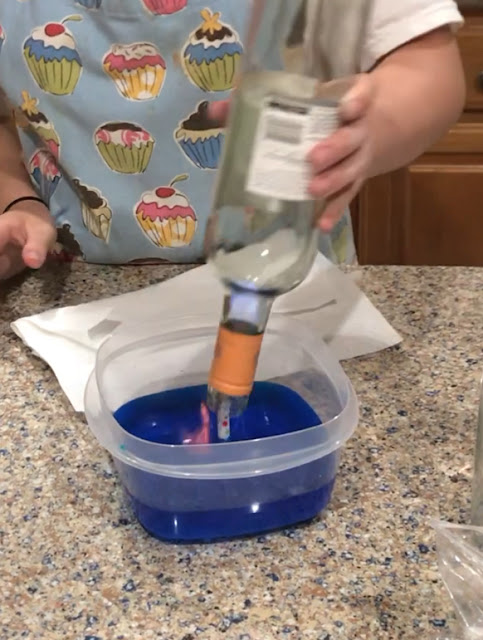My daughter was home briefly and told me she wanted to do an experiment she saw from coolchemistryguy. Unfortunately he explained nothing in his video but looked cool doing it. So I made her do six experiments. This is the one she wanted to do, starring her. I'll explain it.
First, we melt the bottom of a birthday candle and affix it in place at the bottom of a plastic tub. We fill the tub with water, but not above the candle wick, and add some food color for a better viewing experience. Then we take an empty wine bottle and add a little bit of 70% isopropyl alcohol, the same used for hand sanitation everywhere. This time 90% is not required. We roll the alcohol around a bit in the bottle, just enough for vapors to fill and coat the inside. With the candle lit, we place the bottle over the candle and into the liquid. You don't want the bottle to form a seal at the bottom, so if possible keep it down in the liquid but not completely against the bottom. The liquid should rush into the bottle with surprising force, especially if you have done this without the alcohol.
Here she is doing the honors:
Pretty cool! The reason this works is that the candle heats the air in bottle, and that causes it to expand, when placed into the water the bottle cools quickly and pressure drops. As the Ideal Gas Law states, PV = nrT, or more simply, pressure and volume are proportional to temperature. As temperature rises, volume expands and pressure increases. As temperature falls, volume and pressure reduce. So as the pressure drops back down and volume of air in the bottle reduces, it creates a suction that brings the water into the bottle.
Normally this is slow and a bit boring, but alcohol spices things up. The vapor in the bottle is flammable, and when exposed to the flame of the candle, expands rapidly and forcefully (although mostly unnoticed and unseen). This forces most of the gas out of the bottle, which in turn creates a much stronger suction when it cools.
I could not see the gas in the bottle ignite until I looked frame-by-frame. This picture captures a hot (blue) flame shooting momentarily into the neck of the bottle.
I believe the wine bottle worked better than others we tried because the thin neck creates a venturi, speeding the liquid into the bottle. The other way to think of it is that the suction is the same, just over a much smaller area than a mason jar or similar.
This is a great thermodynamics (and fluid dynamics) experiment suitable for kids (well, without the alcohol it is about as safe as a 1st birthday cake).
Thanks for reading,
Paul





No comments:
Post a Comment